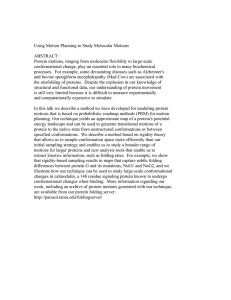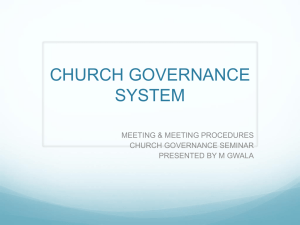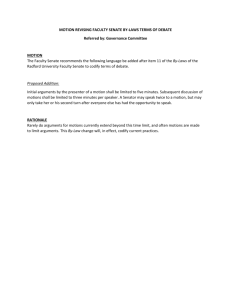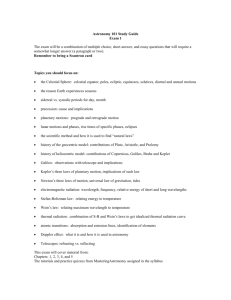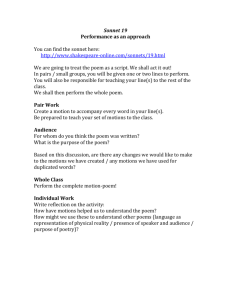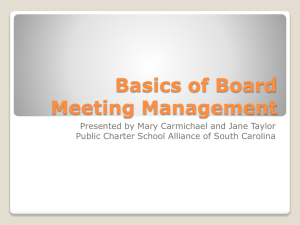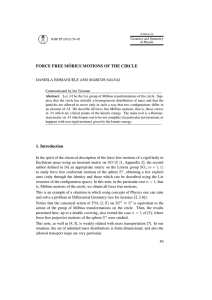Document 10948391
advertisement
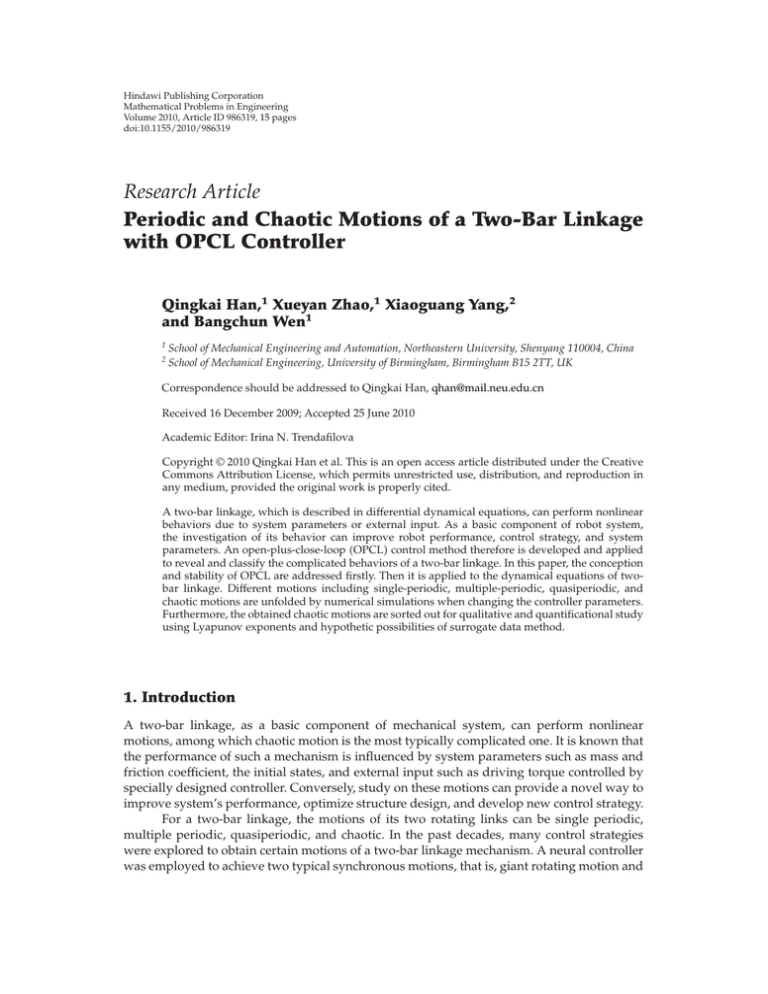
Hindawi Publishing Corporation
Mathematical Problems in Engineering
Volume 2010, Article ID 986319, 15 pages
doi:10.1155/2010/986319
Research Article
Periodic and Chaotic Motions of a Two-Bar Linkage
with OPCL Controller
Qingkai Han,1 Xueyan Zhao,1 Xiaoguang Yang,2
and Bangchun Wen1
1
2
School of Mechanical Engineering and Automation, Northeastern University, Shenyang 110004, China
School of Mechanical Engineering, University of Birmingham, Birmingham B15 2TT, UK
Correspondence should be addressed to Qingkai Han, qhan@mail.neu.edu.cn
Received 16 December 2009; Accepted 25 June 2010
Academic Editor: Irina N. Trendafilova
Copyright q 2010 Qingkai Han et al. This is an open access article distributed under the Creative
Commons Attribution License, which permits unrestricted use, distribution, and reproduction in
any medium, provided the original work is properly cited.
A two-bar linkage, which is described in differential dynamical equations, can perform nonlinear
behaviors due to system parameters or external input. As a basic component of robot system,
the investigation of its behavior can improve robot performance, control strategy, and system
parameters. An open-plus-close-loop OPCL control method therefore is developed and applied
to reveal and classify the complicated behaviors of a two-bar linkage. In this paper, the conception
and stability of OPCL are addressed firstly. Then it is applied to the dynamical equations of twobar linkage. Different motions including single-periodic, multiple-periodic, quasiperiodic, and
chaotic motions are unfolded by numerical simulations when changing the controller parameters.
Furthermore, the obtained chaotic motions are sorted out for qualitative and quantificational study
using Lyapunov exponents and hypothetic possibilities of surrogate data method.
1. Introduction
A two-bar linkage, as a basic component of mechanical system, can perform nonlinear
motions, among which chaotic motion is the most typically complicated one. It is known that
the performance of such a mechanism is influenced by system parameters such as mass and
friction coefficient, the initial states, and external input such as driving torque controlled by
specially designed controller. Conversely, study on these motions can provide a novel way to
improve system’s performance, optimize structure design, and develop new control strategy.
For a two-bar linkage, the motions of its two rotating links can be single periodic,
multiple periodic, quasiperiodic, and chaotic. In the past decades, many control strategies
were explored to obtain certain motions of a two-bar linkage mechanism. A neural controller
was employed to achieve two typical synchronous motions, that is, giant rotating motion and
2
Mathematical Problems in Engineering
small swing motion as stated in 1, 2. A PD feedback controller to obtain chaotic motions for
a two-bar linkage was reported in 3, 4. The bifurcation characteristics of motions of a twobar linkage were presented in 5. The transferring process of a two-bar linkage from perioddoubling bifurcation to chaotic motions was studied by changing control variables in 6. In
recent research, it is known that the open-plus-close-loop OPCL control strategy is powerful
for complicated dynamic systems, as stated in 7, 8, which has been used for chaotic control
of chaotic systems 9 and synchronous systems 10, 11. Besides, the parametric OPCL
method 12 and the nonlinear OPCL method were also applied for motion control of some
dynamic systems 13.
In this paper, an OPCL controller is proposed for a two-bar linkage to achieve different
motions as stated above. The dynamics of the two-bar linkage is modeled with nonlinear
differential equations, followed by the Lyapunov stability analysis of the controlled system.
By changing the two coefficient matrices A and B of the OPCL controller, we obtain typical
motions of the two-bar linkage in numerical simulations including single-periodic, multipleperiodic, quasiperiodic, as well as chaotic motions. These different motions are described in
both qualitative and quantificational ways, such as phase-space portraits, frequency spectra,
Lyapunov exponents, and the hypothetic possibilities of surrogate data.
2. Dynamical Equations of a Two-Bar Linkage with OPCL Controller
2.1. A Dynamical System with an OPCL Controller
Let a typical dynamical system be as follows:
θ̈ F θ, θ̇, t ,
2.1
where θ {θ1 , θ2 , . . . , θn }T is the state variable, and n is the number of DOF of the system.
The given motion goal of the system is
T
g g1 , g2 , . . . , gn .
2.2
Define a tracking error of the two-bar linkage as
T
e θ − g θ1 − g1 , θ2 − g2 , . . . , θn − gn {e1 , e2 , . . . , en }T .
2.3
Equation 2.1 is linearized and expanded in the neighborhood of the goal via Taylor
series and it becomes
∂Fg, ġ, t
∂Fg, ġ, t
θ̈ F θ, θ̇, t Fge, ġ ė, t Fg, ġ, t
e
ėo2 g, ġ
∂g
∂ġ
2
Fg, ġ, t Jg e Jġ ė o g, ġ,
where Jg and Jġ are Jacobian matrices of Fg, ġ, t with respect to g and ġ, respectively.
2.4
Mathematical Problems in Engineering
3
An OPCL controller for the system is designed as 8
U g̈ − Fg, ġ, t − Jg e − Jġ ė Aė Be,
2.5
where the term of g̈ − Fg, ġ, t is the open-loop part, and the term of −Jg e − Jġ ė Aė Be
is the closed-loop part. In this controller, the coefficient matrices A and B are assumed to be
diagonal.
The controlled system, that is, the dynamical system with its OPCL controller, is rewritten as follows:
θ̈ F θ, θ̇, t U
Fg, ġ, t Jg e Jġ ė o2 g, ġ g̈ − Fg, ġ, t − Jg e − Jġ ė Aė Be
2.6
g̈ Aė Be o2 g, ġ.
The tracking error equation defined as 2.3 can be deduced as follows with omitting higherorder term:
ë θ̈ − g̈ g̈ Aė Be o2 g, ġ − g̈ Aė Be.
2.7
It is noticed that, if the controlled system of 2.6 is asymptotically stable when
coefficient matrices A and B are constant and with negative real parts of eigenvalues, that
is, their elements aii and bii should be negative, 2.7 can be rewritten in an expanded form as
⎧ ⎫
ë1 ⎪
⎪
⎪
⎪
⎪
⎬
⎨ ë ⎪
2
.. ⎪
⎪
⎪
.⎪
⎪
⎭
⎩ ⎪
ën
diaga11 , a22 , . . . , ann ⎧ ⎫
ė1 ⎪
⎪
⎪
⎪
⎪
⎬
⎨ ė ⎪
2
.. ⎪
⎪
⎪
.⎪
⎪
⎭
⎩ ⎪
ėn
diagb11 , b22 , . . . , bnn ⎧ ⎫
e1 ⎪
⎪
⎪
⎪
⎪
⎬
⎨e ⎪
2
.. ⎪
⎪
⎪
.⎪
⎪
⎭
⎩ ⎪
en
⎫
⎧
a11 ė1 b11 e1 ⎪
⎪
⎪
⎪
⎪
⎬
⎨ a ė b e ⎪
22 2
⎪
⎪
⎪
⎩
22 2
.
..
⎪
⎪
.
⎪
⎭
ann ėn bnn en
2.8
Thus, if ëi aii ėi bii ei i 1, 2, . . . , n is asymptotically stable, the system is also stable.
Therefore, the aforementioned assumption is true.
A Lyapunov function V is defined as
1 2
bii 2
e −
ė > 0.
2aii i 2aii i
2.9
bii ei ėi − ėi ëi bii ei ėi − ėi aii ėi bii ei −ėi2 < 0.
aii
aii
2.10
V ėi , ei Then
V̇ ėi , ei 4
Mathematical Problems in Engineering
According to the Lyapunov stability theory, it is proved that the error equation of 2.7
is asymptotically stable if the real parts of the eigenvalues of the coefficient matrices A and
B are negative. It can be found that such an OPCL controller is reliable enough to be applied
on a two-bar linkage in order to get different motions as expected and these motions are
asymptotically stable.
2.2. Dynamic Equations of Two-Bar Linkage
A two-bar linkage is shown in Figure 1. Its two joints can be driven, respectively, at o1 and
o2 , so that the upper link Link 1 and the lower link Link 2 can rotate, respectively, around
their own joints of o1 and o2 within the range of -π,π. The upper joint o1 is fixed on the
ground.
In coordinate system O1 xy, as shown in Figure 1, θ1 is the rotating angle of Link 1 with
respect to y-axis, and θ2 is the rotating angle of Link 2 with respect to the centerline of Link 1.
The dynamical equations of the two-bar linkage are given as follows:
M11 M12
M21 M22
θ̈1
K1 θ1 , θ2 C1 θ1 , θ2 , θ̇1 , θ̇2 τ
1 ,
K2 θ1 , θ2 θ̈2
C2 θ1 , θ2 , θ̇1 , θ̇2
τ2
2.11
where
M11 m1 d12 m2 l12 d22 2l1 d2 cos θ2 I1 I2 ,
M21 m2 d22 l1 d2 cos θ2 I2 ,
M12 m2 d22 l1 d2 cos θ2 I2 ,
M22 m2 d22 I2 ,
2.12
−m2 l1 d2 θ̇22
sin θ2 − 2m2 l1 d2 θ̇1 θ̇2 sin θ2 ,
C1 θ1 , θ2 , θ̇1 , θ̇2 C2 θ1 , θ2 , θ̇1 , θ̇2 m2 l1 d2 θ̇12 sin θ2 ,
K1 θ1 , θ2 m1 d1 m2 l1 g sin θ1 m2 d2 g sinθ1 θ2 ,
K2 θ1 , θ2 m2 gd2 sinθ1 θ2 .
In 2.11, mi is the mass of Link i, i 1, 2; Ii is the moment of inertia of Link i with
respect to its mass center, i 1, 2; di is the distance between Link i and joint i, i 1, 2; g is the
acceleration of gravity; τi is driving moment in joint i, i 1, 2.
Equation 2.11 can be rewritten in the following form, which is also in the form of
2.1:
θ̈1
θ̈2
H11 H12 R1
,
H21 H22 R2
2.13
Mathematical Problems in Engineering
5
X
o1
d1
l1
θ1
d2
o2
l2
θ2
Y
Figure 1: The schematic diagram of a two-bar linkage.
Table 1: The values of structural parameters of the two-bar linkage.
Parameter
Value
m1
1
m2
1
I1
0.083
I2
0.33
lc1
0.5
lc2
1
l1
1
l2
2
g
9.8
τ1 − C1 θ1 , θ2 , θ̇1 , θ̇2 − K1 θ1 , θ2 .
τ2 − C2 θ1 , θ2 , θ̇1 , θ̇2 − K2 θ1 , θ2 2.14
where
H11 H12
H21 H22
M11 M12
M21 M22
−1
,
R1
R2
3. Simulations on Different Motions of Two-Bar Linkage
3.1. Conditions and Simulation Steps
In numerical simulations, the dimensionless structural parameters of the two-bar linkage are
used and listed in Table 1.
The goal trajectories of the two rotating angles of the two links, θ1 and θ2 , are designed
as
θ1 t sint,
θ2 t sint.
3.1
The simulation steps, mainly referring to the system of 2.6, are listed herein.
1 Set the initial states and the structural parameter values of the two-bar linkage and
the total number of simulation n.
2 Set the control parameter matrices A and B of the OPCL controller of 2.5.
3 Set the goal trajectory of 3.1.
4 Calculate the joint angles based on 2.6 using the fourth-order Runge-Kutta
method.
6
Mathematical Problems in Engineering
Table 2: The values of control parameters for different motions.
Control parameter A
A diag−10, −10
A diag−16, −16
A diag−8, −8
A diag−2.5, −2.5
Control parameter B
B diag−20, −20
B diag−3, −9
B diag−4, −8
B diag−7, −7
Motion patterns
Single-periodic motions
Multiple-periodic motions
Quasiperiodic motions
Chaotic motions
Simulation results
Section 3.2
Section 3.3
Section 3.4
Section 3.5
With different values of A and B of the OPCL controller, the two-bar linkage can
achieve different motions including single-periodic, multiple-periodic, quasiperiodic, and
chaotic motions. The typical parameter values of A and B and their corresponding motions
are listed in Table 2. They are illustrated in the following sections, which are also listed in the
fourth column of Table 2.
The obtained motions of link joints can be investigated qualitatively and quantificationally in different ways, including observation of frequency spectra and estimation
of nonlinear parameters. Single- or multiamplitude lines in frequency spectra indicate a
periodic motion or a multiple-periodic motion. Wide-range frequency distributions are
often generated from quasiperiodic motion and chaotic motion. In Poincare mapping plots,
one single point or some scattered points are often mapped by periodic motions whereas
attractors with concentrated area and so-called strange attractors are mostly from either
quasiperiodic or chaotic motions. In addition, for chaotic motions, there are also some critical
methods to judge, for example, the well-known nonlinear parameter estimation of positive
maximum Lyapunov exponent 14, 15 and the checking possibility of surrogate data method
16 which is powerful to distinguish a chaotic motion from a random one.
3.2. Single-Periodic Motions
Given A diag−10, −10 and B diag−20, −20, the two-bar linkage can achieve singleperiodic motions. The simulated motions with initial conditions of θ1 1, θ̇1 0, θ2 1, and
θ̇2 0 are shown in Figure 2.
In Figures 2a and 2b, the motions of θ1 and θ2 are obviously periodic, that is,
harmonic. The two phase plane portraits of θ1 and θ2 , shown in Figures 2c and 2d, are
closed curves, which prove that the motions of the two-bar linkage are stable. Furthermore,
the Poincare mapping portrait of each has only one isolated point, as shown in Figures 2e
or 2f. The frequency spectra of the two rotating angles show that there exists only single
dominant frequency of about 0.16 Hz, as shown in Figures 2g and 2h. The simulations
can also show that periodic motions of the two-bar linkage are stable in this case.
3.3. Multiple-Periodic Motions
Given A diag−16, −16 and B diag−3, −9, the two-bar linkage can realize multipleperiodic motions. The typical simulated motions of the two rotating angles are shown in
Figure 3 with initial conditions of θ1 1, θ̇1 0, θ2 1, and θ̇2 0.
In Figures 3a and 3b, the motions of θ1 and θ2 are also periodical but with other
harmonic components. The two phase plane portraits of θ1 and θ2 , shown in Figures 3c and
3d, are closed curves, which can indicate that the motions of the two-bar linkage are stable.
Accordingly, the Poincare mapping portrait of each, shown in Figure 3e or 3f, has some
7
1.5
1.5
1
1
0.5
0.5
θ2 (rad)
θ1 (rad)
Mathematical Problems in Engineering
0
0
−0.5
−0.5
−1
−1
−1.5
0
20
40
60
−1.5
80
0
20
t (s)
1.5
1.5
1
1
0.5
0.5
0
−0.5
−1
−1
0
−1.5
1
−1
0
θ1 (rad)
d Phase-plane portrait of θ2
2
2
1.5
1.5
θ2/ (rad/s)
θ1/ (rad/s)
1
θ2 (rad)
c Phase-plane portrait of θ1
1
0.5
0
−2
80
0
−0.5
−1
60
b Time history of θ2
θ2/ (rad/s)
θ1/ (rad/s)
a Time history of θ1
−1.5
40
t (s)
1
0.5
−1
0
1
2
0
−2
θ1 (rad)
−1
0
θ2 (rad)
e Poincare mapping of θ1
f Poincare mapping of θ2
Figure 2: Continued.
1
2
Mathematical Problems in Engineering
1
1
0.8
0.8
Amplitude (rad)
Amplitude (rad)
8
0.6
0.4
0.2
0
0.6
0.4
0.2
0
0.1
0.2
0.3
0.4
0
0
0.1
Frequency of θ1 (Hz)
g Amplitude spectrum of θ1
0.2
0.3
0.4
Frequency of θ2 (Hz)
h Amplitude spectrum of θ2
Figure 2: Single-periodic motions.
isolated points. There also exist more than two and four obvious frequency lines, as shown in
Figures 3g and 3h, which show that the multiperiodic motions of the two-bar linkage are
stable in this case.
3.4. Quasiperiodic Motions
Given A diag−16, −16 and B diag−3, −9, the two-bar linkage can realize quasiperiodic
motions. The simulated motions of the two joints are shown in Figure 4 with the initial
conditions of θ1 1, θ̇1 0, θ2 1, and θ̇2 0.
It can be seen from Figure 4 that the motions of θ1 and θ2 are complex. Both the time
histories and the phase plane portraits of θ1 and θ2 are difficult to distinguish the motion type
rather than traditional harmonics. The Poincare mapping portrait of each, shown in Figures
4e and 4f, is the concentrated stick-like area. More than six and eight frequency lines
appear in the corresponding frequency spectra of θ1 and θ2 shown in Figures 4g and 4h.
The simulations can also show that the motions of the two-bar linkage are quasiperiodic in
this case.
3.5. Chaotic Motions
Given A diag−2.5, −2.5 and B diag−7, −7, the two-bar linkage can realize chaos
motions. The simulated chaotic motions are shown in Figure 5, in the case of the initial
conditions of θ1 1, θ̇1 0, θ2 1, and θ̇2 0.
From Figures 5a and 5b, the simulated responses of θ1 and θ2 are irregular without
obvious periods. The two phase plane portraits shown in Figures 5c and 5d and the
Poincare mapping shown in Figures 5e and 5f of θ1 and θ2 illustrate irregular shape or
strange attractors. Their corresponding amplitude spectra also unfold multifrequency lines
and explicit broadband ranges. According to the qualitative theory of chaos, these motions
are chaotic in this case.
Mathematical Problems in Engineering
9
0
8
7
−1
θ2 (rad)
θ1 (rad)
6
5
−2
4
−3
3
2
20
40
60
−4
80
20
40
a Time history of θ1
4
2
0
θ2/ (rad/s)
θ1/ (rad/s)
1
−1
0
−2
−2
2
4
6
−4
−4
8
θ1 (rad)
1.2
0.2
1.1
0.1
θ2/ (rad/s)
0.3
1
−0.1
0.8
−0.2
6.8
−1
0
0
0.9
6.6
−2
d Phase-plane portrait of θ2
1.3
0.7
6.4
−3
θ2 (rad)
c Phase-plane portrait of θ1
θ1/ (rad/s)
80
b Time history of θ2
2
−3
60
t (s)
t (s)
7
7.2
−3
θ1 (rad)
−2.5
θ2 (rad)
e Poincare mapping of θ1
f Poincare mapping of θ2
Figure 3: Continued.
−2
Mathematical Problems in Engineering
2
2
1.5
1.5
Amplitude (rad)
Amplitude (rad)
10
1
1
0.5
0.5
0
0
0.2
0.4
0.6
0.8
1
0.2
0.4
0.6
Frequency of θ1 (Hz)
Frequency of θ2 (Hz)
g Amplitude spectrum of θ1
h Amplitude spectrum of θ2
0.8
1
Figure 3: The simulated multiple-periodic motions.
Table 3: The Lyapunov exponents of the simulated chaotic motions of Figure 5.
First
Second
Third
Fourth
Fifth
θ1
0.5496
0.0960
−0.0027
−0.1008
−2.0600
θ2
0.1431
−0.0371
−0.0787
−0.1567
−2.4240
According to the above simulation results, even for the same initial conditions,
controlled behaviors vary with the parameters in the controllers. This is because the basins of
entrainment, whose counterparts in maps are addressed in 9, 10, depend on the parameters
of controller.
4. Discussion on the Simulated Chaotic Motions
In order to quantitatively describe the simulated chaotic motions of the two-bar linkage,
Lyapunov exponent and the hypothesis possibility with surrogate data method are used
based on nonlinear theory 14–17. The first five order Lyapunov exponents of the time series
of θ1 and θ2 are calculated according to algorithm in 14 and shown in Table 3. The calculated
hypothesis possibilities with the surrogate data method 17 for the time series of θ1 and θ2
are shown in Table 4.
As shown in Table 3, the maximum Lyapunov exponents of the motions of angle θ1
and θ2 are 0.5496 and 0.1431, respectively. The positive values indicate that the motions of the
two angles are chaotic.
From the calculated hypothesis possibilities with the surrogate data method for the
motions of θ1 and θ2 , that is, 6.3252 × 10−6 and 3.8644 × 10−19 , it is demonstrated that both of
them are chaotic due to the checking possibility values which are smaller than .05, referring
to an empirical value in 17.
Mathematical Problems in Engineering
11
−2
12
10
−4
θ2 (rad)
θ1 (rad)
8
6
−8
4
2
−6
20
40
60
−10
80
20
40
t (s)
a Time history of θ1
80
b Time history of θ2
10
15
10
θ2/ (rad/s)
5
θ1/ (rad/s)
60
t (s)
0
−5
5
0
−5
−10
−10
2
4
6
8
10
−10
12
−8
−6
−4
−2
θ2 (rad)
θ1 (rad)
c Phase-plane portrait of θ1
d Phase-plane portrait of θ2
−2.05
1.6
1.55
−2.1
1.45
θ2/ (rad/s)
θ1/ (rad/s)
1.5
1.4
1.35
1.3
−2.15
−2.2
−2.25
1.25
8.2
8.25
8.3
8.35
8.4
−2.3
−3.05
θ1 (rad)
−3
−2.95
θ2 (rad)
e Poincare mapping of θ1
f Poincare mapping of θ2
Figure 4: Continued.
−2.9
12
Mathematical Problems in Engineering
2
1.2
1
Amplitude (rad)
Amplitude (rad)
1.5
1
0.8
0.6
0.4
0.5
0.2
0
0
0.5
1
1.5
Frequency of θ1 (Hz)
0.5
1
1.5
Frequency of θ2 (Hz)
g Amplitude spectrum of θ1
h Amplitude spectrum of θ2
Figure 4: The simulated quasiperiodic motion.
Table 4: The calculated values with surrogate data method for chaotic motions.
θ1
θ2
QD
5.5241
8.9715
μs
1.5851
1.5561
χ
4.5152
8.9408
P
6.3252 × 10−6
3.8644 × 10−19
5. Conclusions
In this paper, the dynamical model of a two-bar linkage with OPCL controller is proposed
in order to obtain different motions. It is verified that the OPCL controlled system is
asymptotically stable based on the Lyapunov theory, when the control coefficient matrices
of A and B are diagonal and with negative real parts of eigenvalues. It is reliable to force a
two-bar linkage to achieve different stable motions of θ1 and θ2 .
Numeral simulations are conducted to demonstrate that the two-bar linkage can
achieve single-periodic, multiple-periodic, quasiperiodic, and chaotic motions by changing
the control parameters of A and B of the OPCL controller for θ1 and θ2 successfully. The
proposed OPCL approach works on the given conditions.
Furthermore, for the simulated chaotic motions, the maximum Lyapunov exponents
are positive, that is, 0.5496 and 0.1431, respectively. The calculated hypothesis possibilities
of them with the surrogate data method for the same chaotic motions are 6.3252 × 10−6 and
3.8644 × 10−19 , smaller than .05.
Acknowledgment
The authors gratefully acknowledge that the work was supported by the Key Project
of Science and Technology Research Funds of Chinese Ministry of Education Grant no.
108037.
13
12
5
10
0
8
−5
θ2 (rad)
θ1 (rad)
Mathematical Problems in Engineering
6
−10
4
−15
2
−20
0
20
40
60
−25
80
0
20
20
60
10
40
0
−10
0
−20
−30
−40
5
−60
−30
10
θ1 (rad)
−10
0
10
d Phase-plane portrait of θ2
10
0
8
−5
6
θ2/ (rad/s)
θ1/ (rad/s)
−20
θ2 (rad)
c Phase-plane portrait of θ1
4
−10
−15
2
0
−5
80
20
−20
0
60
b Time history of θ2
80
θ2/ (rad/s)
θ1/ (rad/s)
a Time history of θ1
30
−40
40
t (s)
t (s)
0
5
10
−20
−10
θ1 (rad)
e Poincare mapping of θ1
−5
θ2 (rad)
f Poincare mapping of θ2
Figure 5: Continued.
0
14
Mathematical Problems in Engineering
2.5
4
3
Amplitude (rad)
Amplitude (rad)
2
1.5
1
2
1
0.5
0
0
0.2
0.4
0.6
0.8
frequency of θ1 (Hz)
g Amplitude spectrum of θ1
1
1.2
0.2
0.4
0.6
0.8
1
1.2
Frequency of θ2 (Hz)
h Amplitude spectrum of θ2
Figure 5: The simulated chaotic motions.
References
1 K. Matsuoka, N. Ohyama, A. Watanabe, and M. Ooshima, “Control of a giant swing robot using a
neural oscillator,” in Proceedings of the 1st International Conference on Natural Computation (ICNC ’05),
vol. 3611 of Lecture Notes in Computer Science, pp. 274–282, August 2005.
2 Q. Han, Z. Qin, X. Yang, and B. Wen, “Rhythmic swing motions of a two-link robot with a neural
controller,” International Journal of Innovative Computing, Information and Control, vol. 3, no. 2, pp. 335–
342, 2007.
3 S. Lankalapalli and A. Ghosal, “Possible chaotic motions in a feedback controlled 2R robot,” in
Proceedings of the 13th IEEE International Conference on Robotics and Automation, pp. 1241–1246, IEEE,
April 1996.
4 A. S. Ravishankar and A. Ghosal, “Nonlinear dynamics and chaotic motions in feedback-controlled
two- and three-degree-of-freedom robots,” International Journal of Robotics Research, vol. 18, no. 1, pp.
93–108, 1999.
5 F. Verduzco and J. Alvarez, “Bifurcation analysis of A 2-DOF robot manipulator driven by constant
torques,” International Journal of Bifurcation and Chaos in Applied Sciences and Engineering, vol. 9, no. 4,
pp. 617–627, 1999.
6 K. Li, L. Li, and Y. Chen, “Chaotic motion of a planar 2-dof robot,” Machine, vol. 29, no. 1, pp. 6–8,
2002 Chinese.
7 E. A. Jackson and I. Grosu, “An open-plus-closed-loop OPCL control of complex dynamic systems,”
Physica D, vol. 85, no. 1-2, pp. 1–9, 1995.
8 L.-Q. Chen and Y.-Z. Liu, “A modified open-plus-closed-loop approach to control chaos in nonlinear
oscillations,” Physics Letters A, vol. 245, no. 1-2, pp. 87–90, 1998.
9 L.-Q. Chen, “An open-plus-closed-loop control for discrete chaos and hyperchaos,” Physics Letters A,
vol. 281, no. 5-6, pp. 327–333, 2001.
10 L.-Q. Chen and Y.-Z. Liu, “An open-plus-closed-loop approach to synchronization of chaotic and
hyperchaotic maps,” International Journal of Bifurcation and Chaos, vol. 12, no. 5, pp. 1219–1225, 2002.
11 Q.-K. Han, X.-Y. Zhao, and B.-C. Wen, “Synchronization motions of a two-link mechanism with an
improved OPCL method,” Applied Mathematics and Mechanics, vol. 29, no. 12, pp. 1561–1568, 2008.
12 L.-Q. Chen, “The parametric open-plus-closed-loop control of chaotic maps and its robustness,”
Chaos, Solitons and Fractals, vol. 21, no. 1, pp. 113–118, 2004.
13 Y.-C. Tian, M. O. Tadé, and J. Tang, “Nonlinear open-plus-closed-loop NOPCL control of dynamic
systems,” Chaos, solitons and fractals, vol. 11, no. 7, pp. 1029–1035, 2000.
14 A. Wolf, J. B. Swift, H. L. Swinney, and J. A. Vastano, “Determining Lyapunov exponents from a time
series,” Physica D, vol. 16, no. 3, pp. 285–317, 1985.
Mathematical Problems in Engineering
15
15 A. A. Tsonis and J. B. Elsner, “Nonlinear prediction as a way of distinguishing chaos from random
fractal sequences,” Nature, vol. 358, no. 6383, pp. 217–220, 1992.
16 M. T. Rosenstein, J. J. Collins, and C. J. De Luca, “A practical method for calculating largest Lyapunov
exponents from small data sets,” Physica D, vol. 65, no. 1-2, pp. 117–134, 1993.
17 J. Theiler, S. Eubank, A. Longtin, B. Galdrikian, and J. Doyne Farmer, “Testing for nonlinearity in time
series: the method of surrogate data,” Physica D, vol. 58, no. 1–4, pp. 77–94, 1992.
